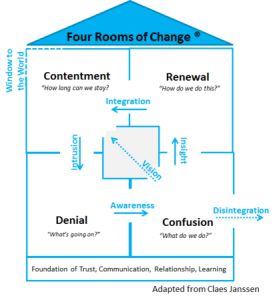How to Navigate Organizational Change and Avoid Dante's Inferno
Navigating organizational change need not be akin to traveling through Dante's Inferno. Unfortunately, we often resist change.
Rather than stepping into new situations, we opt for contentment found in stability. As a business, failing to change can be disastrous. As a leader, how will you guide your organization through the inherent discomforts to reach the next level of success?
In my role as a change facilitator, I guide leaders and their organizations through the journey of change by introducing the Four Rooms of Change model.
Using this model, leaders assess the current state of whether individuals, teams and organizations are ready for change. With an increased understanding of the natural progression of change, leaders skillfully resolve conflict, accelerate change, and increase productivity and creativity.
We all move through the Rooms of Change, but we do so at different paces. Each room represents a mindset where one is likely to get stuck, bringing the team or organization to a standstill.
Meantime, each door represents a threshold that we must cross to move from one room, or mindset, to the next to accept new circumstances. Shared understanding of this model helps foster an organizational culture that embraces change and moves through each room quickly.
The Contentment Room
We happily live in the Contentment Room — at least temporarily — where we are comfortable with our familiar routines, relationships and self-images. When life is “good enough,” we fail to anticipate changes or potential disruptions and often lack the urge to progress.
We stagnate here, ceasing to be creative and harvesting only the fruits of our previous efforts. After 40 years of expansion, consider Borders opening 400 stores across the U.S.
When our contentment is disrupted, we often resist or deny any new reality, and this disruption pushes us into the Denial Room. Borders’ management denied the threat of the Internet and resisted the shift to e-books, continuing to build more stores.
When we are in the Denial Room, often we do not accept where we are and blame others for our circumstances. But when we shift our perception and expand our awareness of our situation, the door to the Confusion and Conflict Room opens.

The Confusion and Conflict Room
The Confusion and Conflict Room is a painful place of chaos, conflict and loss. Our reflex is to escape or take a short-cut. As we attempt to reconcile our new reality with prior self-images, we experience a cognitive dissonance. Until resolved, we feel uncertain or anxious, which may lead to poor choices.
In 2011, Borders could not discern a new path forward. Amid management denial and conflict, new technologies and social trends were taking hold. The company disintegrated in the Confusion and Conflict Room by filing for bankruptcy.
We can navigate the Confusion and Conflict Room by connecting to our yearning for purpose, meaning and a compelling future vision.
As discussed in my last blog post, teams that practice deep futuristic thinking together, especially while they live in the Confusion and Conflict Room, align their actions and gain insight of ways to move forward together.
The Renewal Room
The Renewal Room is a place of learning. Here, we experiment with new ways of doing and of being. We learn to shift patterns, beliefs, habits and processes. We begin to see ourselves differently and endeavor to ensure sustainable progress.
Here, organizations establish new processes, develop new capabilities, and create new partnerships. Building and integrating new habits prevents backsliding into old behaviors and helps alter our self-image. This integration is the threshold to a new Contentment Room, one better suited for our new reality.
In future blogs, I will write about ways to build resilience among individuals and teams to navigate adeptly through the Rooms of Change.




